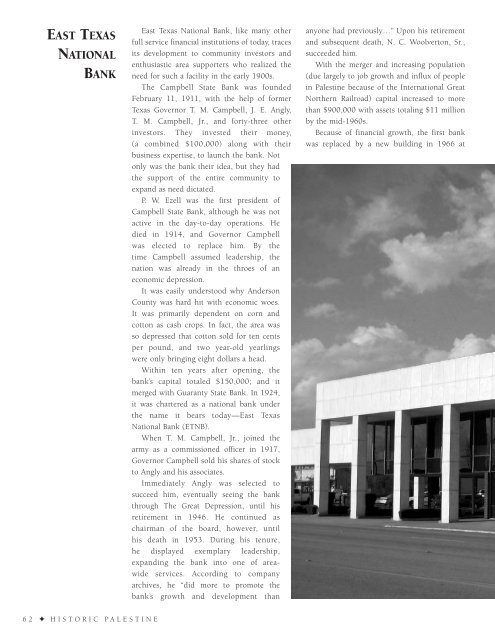Historic Palestine
An illustrated history of the Palestine, Texas area, paired with the histories of companies, families and organizations that make the region great.
An illustrated history of the Palestine, Texas area, paired with the histories of companies, families and organizations that make the region great.
Create successful ePaper yourself
Turn your PDF publications into a flip-book with our unique Google optimized e-Paper software.
EAST TEXAS<br />
NATIONAL<br />
BANK<br />
East Texas National Bank, like many other<br />
full service financial institutions of today, traces<br />
its development to community investors and<br />
enthusiastic area supporters who realized the<br />
need for such a facility in the early 1900s.<br />
The Campbell State Bank was founded<br />
February 11, 1911, with the help of former<br />
Texas Governor T. M. Campbell, J. E. Angly,<br />
T. M. Campbell, Jr., and forty-three other<br />
investors. They invested their money,<br />
(a combined $100,000) along with their<br />
business expertise, to launch the bank. Not<br />
only was the bank their idea, but they had<br />
the support of the entire community to<br />
expand as need dictated.<br />
P. W. Ezell was the first president of<br />
Campbell State Bank, although he was not<br />
active in the day-to-day operations. He<br />
died in 1914, and Governor Campbell<br />
was elected to replace him. By the<br />
time Campbell assumed leadership, the<br />
nation was already in the throes of an<br />
economic depression.<br />
It was easily understood why Anderson<br />
County was hard hit with economic woes.<br />
It was primarily dependent on corn and<br />
cotton as cash crops. In fact, the area was<br />
so depressed that cotton sold for ten cents<br />
per pound, and two year-old yearlings<br />
were only bringing eight dollars a head.<br />
Within ten years after opening, the<br />
bank’s capital totaled $150,000; and it<br />
merged with Guaranty State Bank. In 1924,<br />
it was chartered as a national bank under<br />
the name it bears today—East Texas<br />
National Bank (ETNB).<br />
When T. M. Campbell, Jr., joined the<br />
army as a commissioned officer in 1917,<br />
Governor Campbell sold his shares of stock<br />
to Angly and his associates.<br />
Immediately Angly was selected to<br />
succeed him, eventually seeing the bank<br />
through The Great Depression, until his<br />
retirement in 1946. He continued as<br />
chairman of the board, however, until<br />
his death in 1953. During his tenure,<br />
he displayed exemplary leadership,<br />
expanding the bank into one of areawide<br />
services. According to company<br />
archives, he “did more to promote the<br />
bank’s growth and development than<br />
anyone had previously…” Upon his retirement<br />
and subsequent death, N. C. Woolverton, Sr.,<br />
succeeded him.<br />
With the merger and increasing population<br />
(due largely to job growth and influx of people<br />
in <strong>Palestine</strong> because of the International Great<br />
Northern Railroad) capital increased to more<br />
than $900,000 with assets totaling $11 million<br />
by the mid-1960s.<br />
Because of financial growth, the first bank<br />
was replaced by a new building in 1966 at<br />
6 2 ✦ H I S T O R I C P A L E S T I N E
















